A STEADFAST REFIT
Keep Your Eye On The Prize
Any classic wooden yacht REFIT is, interestingly, and in our case, appropriately, a steadfast process. Oh, come on, don’t groan! It’s honestly the best word to describe the methodology, and I’m a tad corny so could not resist…soooorrrryy! Keeping our sense of humor upon land is not as easy as it appeared it would be, although the people surrounding us are simply wonderful. So. A REFIT can encompass many different aspects of maintenance and/or upgrades that keep a boat seaworthy as well as potentially improve the appearance and functionality.
One of the first things I learned when tossed into the world of boating was that there are as many opinions about how best to maintain a boat as there are sailors sailing. And said sailors are generally happy to convey their opinion. Ah, I know; that’s just human nature. And if I listen, I might just learn something. My mom taught me that; (often with a tinge of sarcasm…). Turns out that (1) I learn something every day, and (2) I turned out just like my mom.
The comprehensive REFIT that we have undertaken during this REPAIR is quite dynamic. While we created a long to-do list and even invested the time to put it into a computer task program, certain tasks must be set aside as other issues arise. Some of that dynamism is definitely weather related; our work is done entirely while SPARRING with sun, rain, dew, temperature swings, wind and lack of predictability. During a REFIT, you methodically remove coatings and fastenings, refresh, refurbish, and then replace, fitting everything back together in the same way but watertight. No small task.
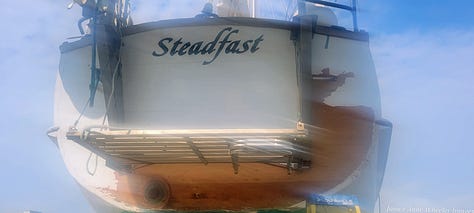

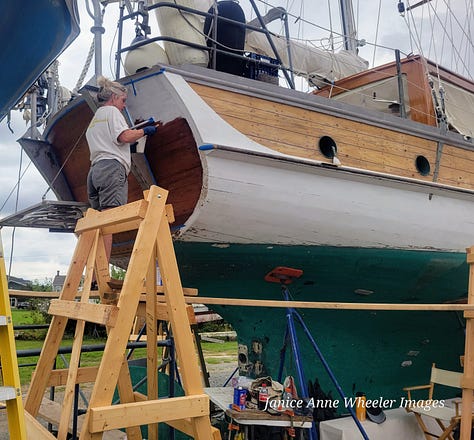
That’s a lot of re-somethings, isn’t it? We are redoing what has already been done, and not for the first time. That turns out to be a very yachty thing, revisiting tasks which, because we have chosen to SPAR WITH MOTHER NATURE and live on top of salty water, need to be redone more often than one might want to.
While you may think it’s aesthetics, the main purpose of paint and varnish is actually to protect the wood, to protect the boat. The reason why teak is so coveted in boatbuilding is that it is hard, strong and resilient, containing natural oils that make teak less necessary to protect and coat in other ways. Traditionally and originally all of the teak on our vessel, which includes the deck and the protective toe rail around the perimeter, were all varnished. Varnishing is both time-consuming and expensive (the industry standard is 10-12 coats, which can be mind-numbing). We have chosen to let those areas fade to what I have come to think of as an attractive gray(!). Everyone who walked by the stripped transom pictured above recommended that we varnish it, but no. No. No. This first mate does NOT need any more wood to varnish; that’s the real reason! Maintaining what we have takes many days a year with sandpaper and paintbrush in hand. On a sunny day with a view of clear warm water that I’ll eventually dive into, well, I don’t complain. Most folks have a lawn to mow, gutters to clean and weeds to pull; we have our own ongoing maintenance.
As part of the REFIT we are rebedding, which ensures that there is no water ingress between any two mating surfaces, mainly the hardware such as rigging, through-hulls and ports, but it can be anything. Rebedding is essential; the entire goal is to keep water out of where it shouldn’t be. STEADFAST weighs 80,000 pounds (even without my wine stashed aboard). Consider that a boat (or anything of that weight) doesn’t really want to float, for goodness sake! Continual vigilance is required to ensure that the design remains flawless. In laymen’s terms, we spend a lot of time and energy making sure she doesn’t leak. I hope the reasons are obvious!
In addition to all the other re-s, the terminology of the entire marine industry involves a vernacular that can be, well, redundant. Let’s take, for example, the word REEF. Off the top of my head I can think of five different meanings for this tiny little word, none of which are truly related to the others. There are reefs you want to experience; and those you don’t.
The first and best reef that comes to mind is the protective coral reefs of the planet. Full of diverse life, those are a favorite part of the oceans we travel upon. They hold not only beauty, but sustenance. We are keeping our eyes on that prize.
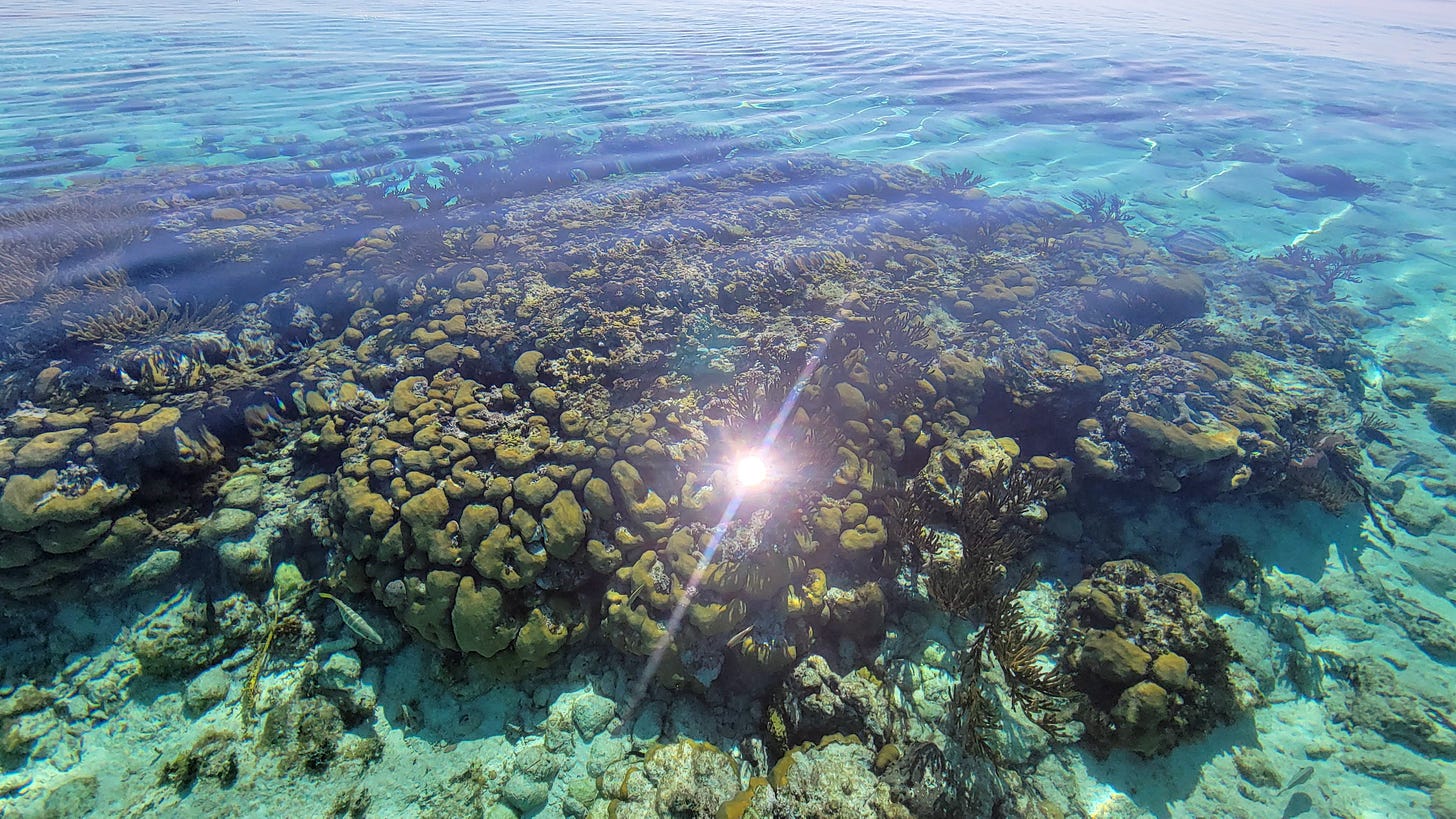
Reef is also used in the mining industry for a vein of gold or other mineral ore. As a verb, sailors reef a sail in order to expose less of the surface in high or increasing winds. While it’s generally thought of as something that is only done to the Mainsail, we also have the ability to reef our smaller aft sail, the Mizzen. Reef has been used since the 1950’s as a term for smoking marijuana, which became the noun reefer at some point or another; we’ve all heard of or participated in that slang.
What a diverse word, right? Those three definitions are all pretty fun! However, I learned another meaning on a hot, humid day in August and that is to pull or to yank. With that perhaps more antiquated definition you find an entire new realm for a single four-letter word! To reef a wallet is to pull it out of someone’s pocket. To reef a horse is to redirect it with the reins. To reef during our REFIT is to pull the cotton (and all other barriers) out from between the wooden planks. 40 years ago, (and 50 years before that, when she was built) each seam was tightly packed with long, cohesive strands of cotton to act as a moisture barrier; this is called caulking. When it comes out fairly easily, it needs to be replaced. When it doesn’t, it is truly difficult to remove.
When it came to reefing the decades-old caulking from hundreds of feet of tight seams, I underestimated the project, just as I have underestimated so many other undertakings along the way. It took me days and days to accomplish only most of it. Some my hands simply could not pry loose.
We are recaulking the majority of the hull above water line. If reefing it was that challenging, I am admittedly apprehensive about putting it all back in. Stay tuned. We’ve used fiberglass for 70 years and wood with cotton or hemp fibers for the previous 6,070 years, give or take a few. I’m sure it works. That doesn’t make it easy.


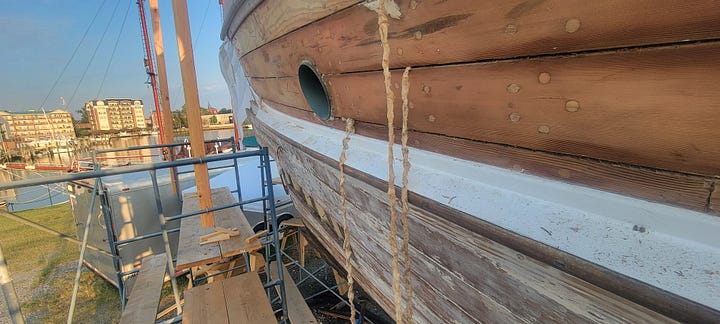

We’ve talked extensively about the ancient art of shipbuilding. Well, it’s not just art, it’s genius, too, isn’t it? And obsession. (Please see THE WOODEN BOAT PHENOMENON).
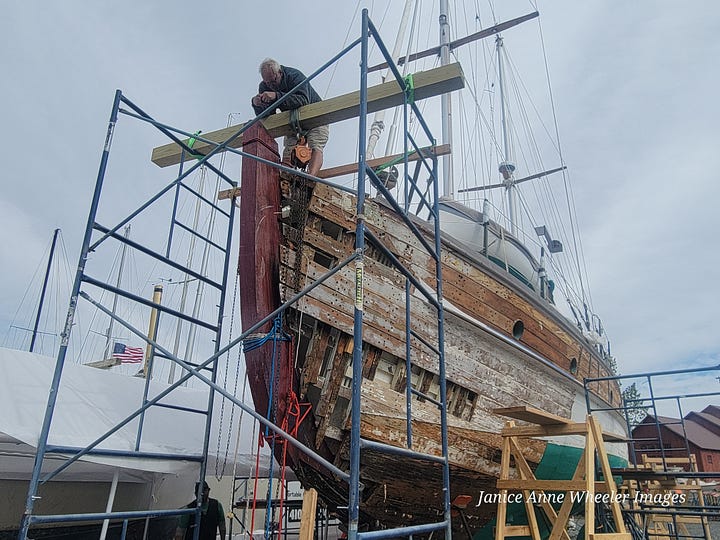
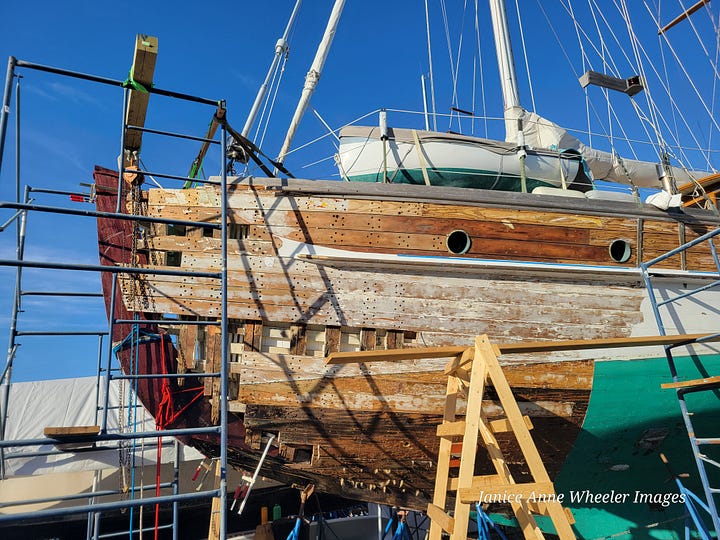
Our stunning weekly sunrise. The fall has brought even more color to the skies, silhouetting cruisers sheltering on their way to warmer climes. I’ll show you every sunrise until the end of the year here at The Sunrise Project.
Substack is a unique way to publish my work and I think all of us, writers and readers alike, are trying to figure it out; it’s easy to get lost in the comments!
If you subscribe to SPARRING WITH MOTHER NATURE these stories are delivered straight to your in-box, no app required. All of my content is available for free, so please share with friends, family and water lovers. If you have the inclination and the means to support my writing financially, it is very much appreciated. If not, you’re still more than welcome here.
Care to comment? Please do. Liked the story? Click the heart or the restack, or both to send my work to new places and people.
Many happy returns! See you next week.
J





…..and always batten down the hatches. Poseidon always favors thems who help themselves…
Simple solution - come visit me!